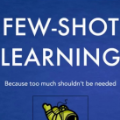Learning to generate a task-aware base learner proves a promising direction to deal with few-shot learning (FSL) problem. Existing methods mainly focus on generating an embedding model utilized with a fixed metric (eg, cosine distance) for nearest neighbour classification or directly generating a linear classier. However, due to the limited discriminative capacity of such a simple metric or classifier, these methods fail to generalize to challenging cases appropriately. To mitigate this problem, we present a novel deep metric meta-generation method that turns to an orthogonal direction, ie, learning to adaptively generate a specific metric for a new FSL task based on the task description (eg, a few labelled samples). In this study, we structure the metric using a three-layer deep attentive network that is flexible enough to produce a discriminative metric for each task. Moreover, different from existing methods that utilize an uni-modal weight distribution conditioned on labelled samples for network generation, the proposed meta-learner establishes a multi-modal weight distribution conditioned on cross-class sample pairs using a tailored variational autoencoder, which can separately capture the specific inter-class discrepancy statistics for each class and jointly embed the statistics for all classes into metric generation. By doing this, the generated metric can be appropriately adapted to a new FSL task with pleasing generalization performance. To demonstrate this, we test the proposed method on four benchmark FSL datasets and gain surprisingly obvious performance improvement over state-of-the-art competitors, especially in the challenging cases, eg, improve the accuracy from 26.14% to 46.69% in the 20-way 1-shot task on miniImageNet, while improve the accuracy from 45.2% to 68.72% in the 5-way 1-shot task on FC100. Code is available: https://github.com/NWPUZhoufei/DAM.
翻译:学会如何生成一个有使命感的基底学习者,这证明这是一个充满希望的方向,可以解决少见的学习(FSL)问题。现有方法主要侧重于为近邻分类或直接产生线性级类而生成一个固定的内嵌模型(例如, Cosine 距离 距离 ) 。然而,由于这样一个简单的衡量或分类器的有限歧视能力,这些方法无法概括到适当的挑战案例。为了缓解这一问题,我们提出了一个全新的深层次的内设元元生成方法,该方法将转向一个正统方向,即 26- 学习以适应的方式为基于任务描述的新FSL任务生成一个具体指标(例如,几个标签样本 ) 。在本研究中,我们用一个三层深度的深视网络来构建一个模型,足够灵活地为每项任务制作一个有歧视性的衡量标准。 此外,与在网络生成的标定样本上使用单调加权重量分配的方法不同, 拟议的元分解(demo-learner) 将一个多式的重量分布取决于跨类样本, 20级的精确度的精确度分布, 。我们可以单独地将45个调调的自动自动解算数据记录, 。




